Fred Kingdom: Research Overview
I am interested in the relationship between the initial stages of vision that detect local features such as edges, bars and surface markings, and intermediate stages that link up those features to form contours, textures and surfaces. A full understanding of this process involves research in a number of domains, including spatial vision, colour vision, stereopsis, texture perception, brightness & lightness perception and transparency. I primarily use psychophysical methods, but also image processing and fMRI. Click on the icons below for details about each project.
Review articles
|
Illusions
|
Contour shape
|
The shape-frequency and shape-amplitude after-effects
Open one of the movies below and fixate the centre spot. After about a minute the movie will stop and you will see two stationary contours. Do you notice a difference in their perceived shape ? The two contours are identical, yet most observers see a difference in shape frequency or shape-amplitude.
The shape frequency after-effect is the shape analog of the well-known spatial frequency after-effect found with luminance gratings. The shape amplitude after-effect might be thought of as the shape analog of the luminance contrast after-effect: the reduction in apparent contrast of a luminance grating one observes after adaptation to a high contrast grating. However, whereas the luminance contrast after-effect is uni-directional, i.e. adaptation only ever reduces the apparent contrast of the test, the shape-amplitude after-effect is bi-directional, i.e. adaptation causes higher amplititude tests to appear higher in amplitude and lower amplitude tests to appear lower in amplitude.
We are currently using the shape-frequency and shape amplitude after-effects to explore the mechanisms of contour-shape and texture-shape perception.
| Shape-frequency after-effect | ||
| Shape-amplitude after-effect | ||
| [MOV - 4MB] | [AVI-8MB] | |
| Quick Time Movie | Win Media Player |
The movies below accompany the paper Gheorghu & Kingdom (2009). Each shows the simulated effect of a different contour segment/gap length on the response of a curvature detector that multiplies its '1st-stage' inputs.
Other papers on contour-shape processing are:
- Schmidtmann, G., Jennings, B. J. & Kingdom, F. A. A. (2015). Shape recognition: convexities, concavities and things in between. Scientific Reports, 5, 17142.
- Gheorghiu, E., Kingdom, F. A. A. & Petkov, N. (2014). Contextual modulation as de-texturizer. Vision Research, 104, 12-23.
- Bell, J., Forsyth, M., Badcock, D. R. and Kingdom, F. A. A. (2014). Global shape processsing involves feature selective and feature agnostic coding mechanisms. Journal of Vision, 14(11):12, 1-14.
- Bell, J., Sampasivam, S., McGovern, D. P., Meso, A. I. and Kingdom, F. A. A. (2014). Contour inflections are adaptable features. Journal of Vision, 14(7):2, 1-14.
- Bell, J., Dickinson, E., Badcock, D. R., & Kingdom, F. A. A. (2013). Measuring Sensitivity to Viewpoint Change with and without Stereoscopic Cues. Journal of Visualised Experiments(82), e50877. doi: doi:10.3791/508.
- Gheorghiu, E., Bell, J. & Kingdom, F. A. A. (2013) Line Orientation Adaptation: Local or Global? PLoS ONE 8(8): e73307. doi:10.1371/journal.pone.0073307
- Bell, J., Kanji, J. & Kingdom, F. A. A. (2013). Discrimination of rotated-in-depth curves is facilitated by stereoscopic cues, but curvature is not tuned for stereoscopic depth. Vision Research, 77, 14-20.
- Gheorghiu, E. & Kingdom, F. A. A. (2012). Chromatic properties of texture-shape and of texture-surround suppression of contour-shape mechanisms. Journal of Vision, 12(6):16, 1-17.
- Gheorghiu, E. & Kingdom, F. A. A. (2012). Local and global components of texture-surround suppression of contour shape coding. Journal of Vision, 12(6):20, 1-19.
- Gheorghiu, E., Kingdom, F. A. A., Bell, J. & Gurnsey, R. (2011). Why do shape after-effects increase with eccentricity? Journal of Vision, 11(14):18, 1-21.
- Bell, J., Gheorghiu, E., Hess, R. F. & Kingdom, F. A. A.(2011). Global shape processing involves a hierachy of integration stages. Vision Research 51, 1760-1766.[PDF]
- Gheorghiu, E., Kingdom, F. A .A. & Witney, E. (2010). Size and shape after-effects: same or different mechanism? Vision Research, 50, 2127-2136.[PDF]
- Bell, J., Hancock, S., Kingdom, F. A. A., & Peirce, J. W. (2010). Global shape processing: which parts form the whole? Journal of Vision, 10(6):16, 1-13.
- Gheorghiu, E., Kingdom, F. A .A. & Varshney, R. (2010) Curvature coding is tuned for motion direction. Journal of Vision, 10(3):18, 1-19.
- Bell, J., Gheorghiu, E. & Kingdom, F. A. A. (2009) Orientation tuning of curvature adaptation reveals both curvature-polarity selective and non-selective mechanisms. Journal of Vision, 9(12):3, 1-11.
- Gheorghiu, E., Kingdom, F. A. A., Sull, M. & Wells, S. (2009) Curvature coding in illusory contours. Vision Research, 49, 2518-2530.[PDF]
- Gheorghiu, E., Kingdom, F. A. A., Thai, M-T, & Sampasivam, L. (2009) Binocular properties of curvature-encoding mechanisms revealed through two shape after-effects. Vision Research, 49, 1765-1774.[PDF]
- Gheorghiu, E. & Kingdom, F. A. A. (2009) Multiplication in curvature processing. Journal of Vision, 9(2):23, 1-17.
- Bell, J. & Kingdom, F. A. A. (2009) Global contour shapes are coded differently from their local components. Vision Research, 49, 1702-1710.[PDF]
- Kingdom, F. A. A. & Prins, N. (2009) Texture-surround suppression of contour shape coding in human vision. Neuroreport, 20, 5-8.[PDF]
- Gheorghiu, E. & Kingdom, F. A. A. (2008) Spatial properties of curvature-encoding mechanisms revealed through the shape-frequency and shape-amplitude after-effects. Vision Research, 48, 1107-1124.[PDF]
- Gheorghiu, E. & Kingdom, F. A. A. (2007) Chromatic tuning of contour-shape mechanisms revealed through the shape-frequency and shape-amplitude after-effects. Vision Research, 47, 1935-1949.[PDF]
- Gheorghiu, E. & Kingdom, F. A. A. (2007) The spatial features underlying the shape-frequency and shape-amplitude after-effects. Vision Research, 47, 834-844.[PDF]
- Prins, N., Kingdom, F. A. A. & Hayes, A. (2007) Detecting low shape-frequencies in smooth and jagged contours. Vision Research, 47, 2390-2402.[PDF]
- Gheorghiu, E. & Kingdom, F. A. A. (2006) Luminance-contrast properties of contour-shape processing revealed through the shape-frequency after-effect. Vision Research, 46, 3603-3615.[PDF]
Natural scenes
|
How sensitive are we to transformations in natural scenes? Some transformations, such as the affine transformations of translation, rotation and scaling, and photometric transformations in mean luminance and contrast, are part of our natural visual experience. Others, such as the addition of noise, are not. We have measured thresholds for detecting a range of transformations, measured in terms of the the Euclidean distance of pixel intensities. The results show that humans are most sensitive to the transformations that are least likely to be experienced in everyday vision: see Kingdom, Field & Olmos (2007). Other projects have dealt with sensitivity to uniform colour changes in natural scene and the spatio-chromatic structure of natural scenes.
Colour, shadows and shading
|
The colour-luminance plaid c, formed by combining the luminance
grating a with the purple-green chromatic grating b,
gives the impression of a curtain folded in depth and illuminated obliquely.
This is an example of 3D-shape-from-shading that is triggered by colour
contrast. When a second purple-green grating is added in alignment with the
luminance grating, as in d, the perception of 3D shape-from-shading
is eliminated. I refer to the capacity of colour variations to enhance
and suppress 3D shape-from-shading as the ‘colour
shading effect’.
The colour shading effect reveals two built-in assumptions: a) chromatic variations, and those luminance variations that are spatially aligned with them, arise from surfaces; b) pure, or near-pure luminance variations, i.e. those non-aligned with chromatic variations, arise from inhomogenous illumination, such as shading. The colour-shading effect is the first evidence that the visual system has prior knowledge about the chromatic-luminance structure in natural scenes, and uses this knowledge to parse the image into surface and illumination.
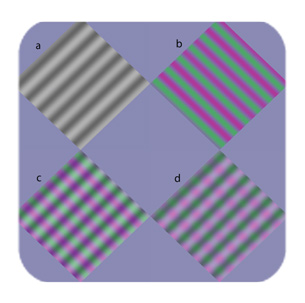 |
Colour and global processing
|
Colour vision is useful for detecting camouflaged objects, such as red berries against green foliage. However, it does not follow that mechanisms involved in extracting global features of multi-element arrays are necessarily tuned for colour. We considered whether global motion and global stereopsis mechanisms are colour-tuned. In all our stimuli, multi-element "targets" were embedded in irrelevant "distractors", and target and distractors were either different in colour, termed 'colour-segregated', or were constructed from equal numbers of both colours, termed 'colour-nonsegregated'. For both the motion and stereopsis tasks, performance was no better in the colour-segregated than colour-nonsegregated conditions, unless the stimulus/task was designed in such a way that subjects could selectively attend to the target colour. We conclude that global motion and stereopsis mechanisms are not tuned for colour.
Colour and stereopsis
|
The goal of this project is to determine the strengths and limitations of colour vision when supporting stereoscopic depth perception. Our studies have shown that colour vision has its own mechanism for stereopsis (Simmons & Kingdom, 1997), but requires more contrast than its luminance-based counterpart to achieve an equivalent level of stereoscopic performance (Simmons & Kingdom, 1994, 1995; Kingdom & Simmons, 1996). Colour-based stereopsis also appears to be deficient when processing the depth of colour-contrast-modulated ("Chromatic 2nd-order") stimuli (Simmons & Kingdom, 1995) and is very poor at supporting stereoscopic surface perception (Kingdom, Simmons & Rainville, 1999). Finally, there is at least as much, if not more binocular summation of colour than luminance information (Simmons & Kingdom, 1998), suggesting that binocular summation and stereoscopic performance are not as closely correlated as previously thought.
Basic colour mechanims
|
Neurophysiological results show that neurons in the visual pathways and the early stages of cortical processing respond to both color and luminance information. This is perplexing since there is psychophysical evidence for independent colour and luminance detection mechanisms. The question arises as to how separate color and luminance mechanisms are derived from neural responses which confound the two. We addressed this problem by constructing computer models of cortical neurons encoding colour and luminance contrast (Kingdom & Mullen, 1995). We critically evaluated possible models for separating colour and luminance information in the cortex, and outlined the constraints under which they would operate. For example, we showed that considerable spatial summation would be required to derive a colour sensitive unit insensitive to luminance contrast, which implies a central limit to chromatic resolution.
A second topic of interest has been the manner in which cones are fed into retinal P-cells. One view is that cones are selectively fed into P-cells, for example with L (long wavelength sensitive) cones fed into the centre and M (middle wavelength sensitive) cones fed into the surround. An alternative view is that cones are non-selectively fed into P-cells. In this view colour opponency arises by chance, specifically by chance differences in the relative numbers of L and M cones in centre and surround. This is termed the "hit and miss" hypothesis. We have shown that the rapid decline of colour contrast sensitivity with eccentricity can be explained by the "hit and miss" hypothesis, by combining others' measurements of the anatomical distributions of cones and P-cells across the primate retina, others' measurements of the receptive field sizes of P-cells, and our own simple mathematical model of cone-to-P-cell mapping (Mullen and Kingdom, 1996). Finally, we have recently shown that blue-yellow contrast sensitivity does not decline precipitously as does red-green contrast sensitivity, sugesting a quite different retinal architecture for the blue-yellow system (Mullen & Kingdom, 2002).
Texture gradient detection
|
Texture gradients can arise in the retinal image of any textured surface because of perspective, and are useful for determining surface shape. Orientation gradients appear to be particularly important. We were the first to measure the Orientation Modulation Function (OMF), which describes how sensitivity to a sinusoidal modulation of orientation depends on modulation, or "texture", spatial frequency (Kingdom, Keeble & Moulden, 1995). More recent experiments have shown that, for example, two superimposed orientation-modulated textures segment when differing by as little as an octave in luminance spatial frequency (Kingdom & Keeble, 2000). We have also shown that texture-orientation mechanisms pool colour and luminance carrier information (Pearson & Kingdom, 2002).
An important question concerns whether different types of texture gradients, such as orientation modulated (OM), frequency modulated (FM) and contrast modulated (CM) textures are processed by different or common mechanisms. Recent cross-facilitation experiments support the idea of separate mechanisms (Kingdom, Hayes & Prins, 2003). Prins & Kingdom (2002), using an adaptation paradigm, have qualified this result by showing that what is "different" is the carrier tuning of each Filter-Rectify-Filter mechanism, which is selected to maximize the response to the particular texture modulation under investigation. Below are examples of OM and FM textures.
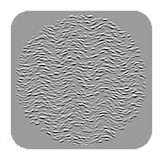 |
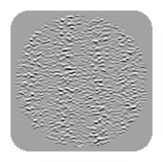 |
Texture statistics
|
The most recent project (with Motoyoshi) determined the types of local pairwise relations in dense textures that we are most sensitive to, and the answer is the ones that are co-circular.
Other projects have considered what are the texture statistics to which we are most sensitive. For example the textures below are constructed by dropping thousands of gabors of different orientations and spatial-frequencies, in specific relative numbers. If enough gabors are dropped, the texture approximates 1/f noise. By varying the contrast, phase and density of the gabors one can manipulate the 2nd (variance), 3rd (skew) and 4th (kurtosis) of the texture's pixel histogram, as well as the texture histogram after convolution with a wavelet filter. We found that observers were more sensitive to differences in the 4th moment, or kurtosis, between wavelet textures, than to differences in the 2nd (variance) and 3rd (skew) moments. This reinforces the importance of kurtosis as a texture statistic. Conventional Filter-Rectify-Filter models of texture segregation cannot segregate textures that differ only in kurtosis. A further stage of rectification and filtering is necessary.
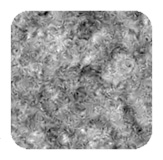 |
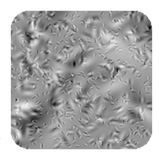 |
Synthetic wavelet-textures with low (left) and high (right) kurtosis respectively
Lightness, brightness and transparencyi |
An important clue to the way the visual system processes the brightness (perceived luminance) and lightness (perceived reflectance) of surfaces comes from an examination of the errors it makes, for example simultaneous brightness contrast, or SBC. SBC has been known about since the time of Aristotle, but, remarkably, it still provokes controversy. Mark McCourt, Barbara Blakeslee, myself and others (and most undergraduate textbooks!) champion the idea that SBC is primarily a result of the operation of spatial bandpass mechanisms, traditionally referred to as manifesting "lateral inhibition", in conjunction with nonlinearities such as contrast normalization (for a recent model implementation see Blakeslee & McCourt, 1999, Vis. Res., 39, 4361). There is also evidence for an additional mechanism that discounts inhomogenous illumination, such as shadows, shading and achromatic transparency, and that as a result dramatically enhances SBC, such as in the figures recently popularised by Adelson, Logvinenko and others.
Stereoscopic surface perception
|
Symmetry perception
|
This research was carried out as part of Stephane Rainville's PhD thesis.







